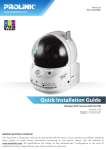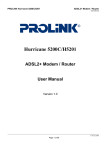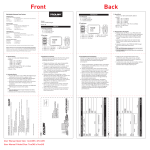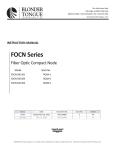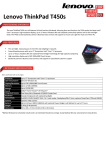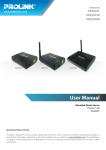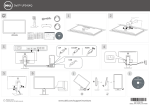Download User Manual
Transcript
MODEL NO: PRO1301WE Front Cover Page User Manual 13.3 Super-Slim Portable USB Monitor Version 1.00 (English) BEFORE GETTING STARTED This document is designed to aid you to get started with the device. If you experience problems following these guides or need further information pertaining to the device, please visit our website at www.prolink2u.com. All specifications are subject to the manufacturer’s configuration at the time of shipping and may change without prior notice, written or otherwise. Table of Contents Chapter 1 Content Description P1 Section 1 Notices for using Mobile Monitor P1 Section 2 Safety Instructions P2 Section 3 Safety Precautions P2 Section 4 Product Maintenance P2 Section 5 LCD Pixel Statement P2 Section 6 Mobile Monitor and Accessories P2 Chapter 2 Installation Instructions P4 Section 1 Horizontal Display P4 Section 2 Vertical Display P5 Section 3 Upward Extension Display P6 Section 4 Dual Monitor Display P7 Section 5 Remove Mobile Monitor’s Holder Plate P10 Chapter 3 Power On and Off the Mobile Monitor P11 Section 1 Operating Instructions P11 Section 2 Monitor Display Setting P11 Chapter 4 Using with other 3C Products P15 Chapter 5 Hot Keys and OSD Instructions Section 1 Hot Keys Description Section 2 OSD Description P16 Section 3 Other Functions of OSD P19 Chapter 6 Specification Section 1 Plug and Play P16 P16 P20 P20 Section 2 Standard Default Modes P20 Section 3 Troubleshooting P20 1 Chapter 1 Content Description Section 1 Notices of using Mobile Monitor 1. The cable may be damaged if you pull it out by force. To disconnect power cable connector from the Mobile Monitor, please push the connector towards right hand side as illustration shown. Warning: DO NOT unplug by pulling the cord. Fig.: Push out the connector towards right hand side. 2. Notice when installing the Mobile Monitor onto your laptop: ● When using PRO1301WE, first flip the Mobile Monitor to horizontal position, and then only open the laptop’s monitor. Avoid knocking against objects on the table. ● The laptop’s monitor should be positioned in an upright position to prevent it from toppling. If the laptop’s monitor tilts, it means the laptop might not be able to sustain the weight. ● As shown below, it is recommend- ed to rotate the Mobile Monitor to proper viewable position to the user (i.e., angle between 180° 225°) ● Keep the laptop away from the table edge to prevent it from falling off the table if it topples. ● Use the laptop and Mobile Monitor on a flat surface. Otherwise, the laptop and Mobile Monitor may topple. 3. PRO1301WE Mobile Monitor only reads DVI Digital Video signal; it does not support complete HDMI interface and does not have a speaker. 2 Section 2 Safety Instructions Please read this Manual carefully and observe the operation instructions and precautionary notes. Do retain this document for future reference. Section 3 Safety Precautions 1. The Product may be severely damaged from overturning or falling. Please DO NOT place on a shaky or unstable table, cupboard or trolley. DO NOT use the product on a moving vehicle. 2. DO NOT place the Product on a vibrating surface as continuous vibration may damage the internal components of the product. 3. The Product is not waterproof. DO NOT use the Product near water or in wet environment. 4. DO NOT insert any object into the Product’s slots or gaps. Section 4 Product Maintenance 1. DO NOT attempt to repair the Product by yourself. Please send it to our authorized service center for repair. 2. Should any of the following conditions occur, please contact our service center for repair: ● Unable to operate the Product after following the instructions in this Manual. ● The Product falls and the outer casing is damaged. ● Power cable or Video cable is damaged, worn or torn. ● Liquid infiltrated into the Product. Section 5 LCD Pixel Statement The LCD screen is manufactured using high precision technology. Due to the nature of the complex manufacturing process, the screen may have defects that appear as (bright and dark) dots on the screen cosmetically. This does not impair the performance of the Mobile Monitor and is not considered defective in the industry. Section 6 Mobile Monitor and Accessories 1. Front / Rear Panel Description: Fig.: Front view of PRO1301WE Fig.: Rear View of PRO1301WE Left: Front view of the Holder Plate Right: Rear view of the Holder Plate 3 2. Package Contents : ● PRO1301WE Mobile LED Monitor x1 ● Digital Video Input and USB-Powered Y cable x1 ● Holder Plate x1 ● Double-sided adhesive tape x6 ● Non-woven bag x1 ● Quick Installation Guide x1 ● User Manual x1 Fig.: Digital Video and USB-Powered Y cable 3. Optional Accessories ● Analog Video Input and USB-Powered Y cable Fig.: Analog Video and USB-Powered Y cable ● Mini-DisplayPort (MiniDP) Input and USB-Powered Y cable Fig.: Mini DisplayPort and USB-Powered Y cable 4 Chapter 2 Installation Instructions Section 1 Horizontal Display Step1. Install the Video and USB-Powered cable If you wish to use the HDMI port on the laptop, please use Digital Video and USBPowered Cable. If you wish to use the D-sub (VGA) or mini-Display Port on the laptop, please purchase the Analog Video and USB-Powered Cable or mini-Display Port and USB-Powered Cable from our authorized service center. Connect the Video and Power connector to Mobile Monitor Video port, (1) Insert the latch into the groove of the video power connector. (2) Slide the video power connector toward the left for a proper connection. [WARNING: Not inserting the latch into the groove may result in damage to the connector. Please check the video power connector is properly connected and not protruding out. If protrusion occurs, the connection might not be properly connected and monitor will not be able to operate.] Fig.: Insert the latch into the groove of the video power connector of the Mobile Monitor Step2.Connect Mobile Monitor to the laptop Connect the USB-Powered connector to the laptop's USB port, and then the Digital Video connector to the laptop's HDMI Video output port ● If Analog Video and USB-Powered cable is used, connect the Analog Video connector to the laptop's D-sub port ● If miniDP and USB-Powered cable is used, connect the miniDP connector to the laptop's D-sub port Fig.: Horizontal display of Mobile Monitor 5 Step3. Adjust the laptop and monitor extension setting (Refer to Section 2 of Chapter 3 for monitor display setting.) After powering on the laptop, go to Windows’ "Control Panel" to adjust the monitor extension setting. If you are using Windows 7: Select "2.DVI LCD" (Digital Video) or “2. display device: VGA” (Analog Video) for Display. Select "1366x768" for Resolution Select "Landscape" for Orientation Select "Extend these displays" for Multiple monitors, and drag Display 2 to the right side of Display 1. Section 2 Vertical Display Step1. Install the Video and USB-Powered cable If you wish to use the HDMI port on the laptop, please use Digital Video and USBPowered Cable. If you wish to use the D-sub (VGA) or mini-Display Port on the laptop, please purchase the Analog Video and USB-Powered Cable or mini-DisplayPort and USB-Powered Cable from our authorized service center. Connect the Video and Power connector to Mobile Monitor Video port, (1) Insert the latch into the groove of the video power connector. (2) Slide the video power connector toward the left for a proper connection. [WARNING: Not inserting the latch into the groove may result in damage to the connector. Please check the video power connector is properly connected and not protruding out. If protrusion occurs, the connection might not be properly connected and monitor will not be able to operate.] Fig.: Insert the video power connector to the video power port of Mobile Monitor 6 Step2. Connect Mobile Monitor to the laptop It is recommended to place the vertical standing Mobile Monitor to the right side of the laptop for a better viewing angle. As illustrated, connect the USB-Powered connector to the laptop's USB port, and then the Digital Video connector to the laptop's HDMI Video output port ● If Analog Video and USB-Powered cable is used, connect the Analog Video connector to the laptop's D-sub port ● If miniDP and USB-Powered cable is used, connect the miniDP connector to the laptop's D-sub port Note: Place Mobile Monitor to the right for better view Fig.: Vertical display of Mobile Monitor Step3.Adjust the laptop and monitor extension setting (Refer to Section 2 of Chapter 3 for monitor display setting.) After powering on the laptop, go to Windows’ “Control Panel” to adjust the monitor extension setting. If you are using Windows 7: Select “2.DVI LCD” (Digital Video) or “2. display device: VGA” (Analog Video) for Display Select “1366x768” for Resolution Select "Portrait (flipped)" for Orientation Select "Extend these displays" for Multiple displays, and drag Display 2 to the right side of Display 1. Section 3 Upward Extension Display Step1. Install the Video and USB-Powered cable If you wish to use the HDMI port on the laptop, please use Digital Video and USBPowered Cable. If you wish to use the D-sub (VGA) or mini-Display Port on the laptop, please purchase the Analog Video and USB-Powered Cable or mini-DisplayPort and USB-Powered Cable from our authorized service center. Connect the Video and Power connector to Mobile Monitor Video port, (1) Insert the latch into the groove of the video power connector. (2) Slide the video power connector toward the left for a proper connection. [WARNING: Not inserting the latch into the groove may result in damage to connector. Please check the video power connector is properly connected and not protruding out. If protrusion occurs, the connection might not be properly connected and monitor will not be able to operate.] Fig.: Insert the video power connector to the video power port of Mobile Monitor 7 Step2. Connect Mobile Monitor to the laptop Place the laptop in front of the Mobile Monitor and align the upper side of the laptop to the lower display edge of the Mobile Monitor. Connect the USB-Powered connector to the laptop's USB port, and then connect the Digital Video connector to the laptop's HDMI Video output port. ● If Analog Video and USB-Powered cable is used, connect the Analog Video connector to the laptop's D-sub port ● If miniDP and USB-Powered cable is used, connect the miniDP connector to the laptop's D-sub port Step3.Adjust the laptop and monitor extension setting (Refer to Section 2 of Chapter 3 for monitor display setting.) After powering on the laptop, go to Windows’ "Control Panel" to adjust the monitor extension setting. If you are using Windows 7: Select "2.DVI LCD" (Digital Video) or "2. display device: VGA" (Analog Video) for Display. Select "1366x768" for Resolution Select "Landscape" for Orientation Select "Extend these displays" for Multiple displays, and drag Display 2 to the top side of Display 1. Section 4 Dual Monitor Display [Note: Ultrabook or laptop of smaller size than Mobile Monitor may not be suitable for this usage.] Step1. Install the Holder Plate to the front cover of the laptop’s monitor Open the shaft’s Hinge Plate of the Mobile Monitor to 180° and place the Mobile Monitor on the laptop's front cover. Peel off the other double-sided adhesive tape on the Holder Plate and attach the Holder Plate to the laptop, as illustrated. Note: 1) Keep the Holder Plate 2mm from the edge of the laptop. 2) Align the Mobile Monitor to the front edge of the laptop's front cover. 3) Keep the direction of the Holder Plate the same as that of the shaft’s Hinge Plate 4) If the Holder Plate cannot securely attach to the laptop because the laptop’s front cover has a protruding pattern or is anodized, use more double-sided adhesive tape as required. 5) Double-sided adhesive tape should be used on a horizontal surface; gently press on the adhesive tape after the Holder Plate is attached. Leave for 2 hours before installing the Mobile Monitor. 8 Fig.: Mounting the Holder Plate [Note: Do not reverse the direction of the Holder Plate as this will reverse the direction of the Mobile Monitor after installation.] Step2 Install the Video and USB-Powered cable If you wish to use the HDMI port on the laptop, please use Digital Video and USBPowered Cable. If you wish to use the D-sub (VGA) or mini-Display Port on the laptop, please purchase the Analog Video and USB-Powered Cable or mini-Display Port and USB-Powered Cable from our authorized service center. Connect the Video and Power connector to Mobile Monitor video port, (1) Insert the latch into the groove of the video power connector. (2) Slide the video power connector toward the left for a proper connection. [WARNING: Not inserting the latch into the groove may result in damage to the connector. Please check the video power connector is properly connected and not protruding out. If protrusion occurs, the connection might not be properly connected and monitor will not be able to operate.] Step3 Install Mobile Monitor to the laptop’s monitor 1. As illustrated, align the shaft’s Hinge Plate of the Mobile Monitor with the Holder Plate, and slide the shaft’s Hinge Plate into the Holder Plate. Fig.: Slide the shaft’s Hinge Plate into the Holder Plate The positioning clip protrudes at the first positioning hole Fig.: Make the positioning clip wedge to the first positioning hole 9 2. Rotate the Mobile Monitor clockwise so that it is parallel to the laptop, open the laptop monitor and the Mobile Monitor at the same time, as illustrated. 3. Adjust the angle of the Mobile Monitor. A recommended angle is between 180° and 225°. Fig.: Rotate the Mobile Monitor to the right side, then open the laptop monitor and the Mobile Monitor at the same time. Fig. A recommended angle is between 180° and 225°. 4. Connect the Video and power cable As illustrated, connect the USB-Powered connector to the laptop's USB port, and then the Digital Video connector to the laptop's HDMI Video output port ● If Analog Video and USB-Powered cable is used, connect the Analog Video connector to the laptop's D-sub port ● If miniDP and USB-Powered cable is used, connect the miniDP connector to the laptop's D-sub port Fig.: Dual monitor display mode 5. As illustrated, move the Mobile Monitor upward from the laptop’s front cover, press on the positioning clip at the first positioning hole, and move the Mobile Monitor until the positioning clip pops up from the second positioning hole. Fig.: Moving the positioning clip from the first positioning hole to the second positioning hole. After Mobile Monitor moves up, it is no longer fixed to the bottom of the laptop, and the laptop’s monitor can be tilted backward. [Note: If your laptop is smaller than Mobile Monitor, the cable may get stuck when flipping the Monitor (see upper right figure). Follow the steps above to adjust the monitor height.] 10 Step4.Adjust the laptop and monitor extension setting (Refer to Section 2 of Chapter 3 for monitor display setting.) After powering on the laptop, go to Windows’ "Control Panel" to adjust the monitor extension setting. If you are using Windows 7: Select "2.DVI LCD" (Digital Video) or “2. display device: VGA” (Analog Video) for Display Select "1366x768" for Resolution Select "Landscape" for Orientation Select "Extend these displays" for Multiple displays, and drag Display 2 to the right side of Display 1. Step5.Remove Mobile Monitor from the laptop 1. Remove the Mobile Monitor from the laptop. As illustrated, rotate clockwise and open the Mobile Monitor, press on the positioning clip, and pull forward the Mobile Monitor along the Holder Plate to slide out the shaft’s Hinge Plate. Fig.: Press on the positioning clip to slide out the shaft’s Hinge Plate from the Holder Plate. Section 5 Remove Mobile Monitor’s Holder Plate 1. First, remove the Mobile Monitor 2. Insert a ruler or rigid flat article into the gap at bottom of the Holder Plate; gently and evenly apply force back and forth to make the double-sided adhesive tape lose its viscosity. Do not use metal objects that can easily scratch the surface. [Note: DO NOT try to lift up the Holder Plate directly with hands as it may result in deformation of the Holder Plate for reuse.] 11 Chapter 3 Power On and Off the Mobile Monitor Section 1 Operating Instructions 1. Initial use: when the Monitor’s USB-Powered cable is connected to a 5V DC power source (for example connected to laptop USB port), PRO1301WE will automatically switch on. 2. Switching on the Mobile Monitor from an off mode: press “Power” to switch on the Mobile Monitor. 3. Follow the steps below to proceed with the monitor display setting. 4. When Mobile Monitor is on, you may press the “power” button to switch off Mobile Monitor. Section 2 Monitor Display Setting 1. Set resolution –Windows 7 system ● Click on icon at the bottom left of the screen, and a menu will be display. ● Click on Control Panel ● Click on Appearance and Personalization ● Click on Display > Connect to an external display ● Normally Display 1 is the laptop’s monitor, Display 2 is the external monitor. Click on Detect if you are unsure. 12 ● At Display, select “2.DVI ● ● ● ● 2. LCD” (Digital Video) or “2. display device: VGA” (Analog Video) for Display Select "1366x768" for Resolution Select "Landscape" or "Portrait" for Orientation Select "Extend these displays" for Multiple display, and drag Display 2 to the right side of Display 1. For Duplicated mode, select "Duplicate these displays". Select OK and exit after saving the settings. Resolution setting– Windows XP system ● Click on Start ● Click on Setting > Control Panel ● Click on Appearance and Theme ● Click on Adjust screen resolution 13 ● Click on Setting, select Monitor at Display, and set the Screen Resolution as 1366x768; Select "Extend my Windows desktop to this monitor" and then select ”OK” and exit. [Note: "Vertical mode" cannot be directly chosen on Windows XP system; the adjustment needs to be made via the video card. Please refer to the user manual of your video card.] 3. Setting the MAC Operating System [Note: In order to make the Mobile Monitor and MacBook display quality closer to each other, Color LCD and DVI LCD must have the same color settings. This setting requires the conversion cable from the Digital AV adaptor to HDMI connector to connect with the Digital Video cable of PRO1301WE; or use the Mini DisplayPort USB-Powered cable available for purchase from our service center.] ● Click on Displays ● Click on System Preferences ● The above window appears on the laptop’s monitor ● The above window appears on the Mobile Monitor. Please adjust the resolution. 14 ● Select the arrangement mode to adjust the display position of the monitors; this is the dual monitor display mode (laptop’s monitor) ● This is the upward extension mode (laptop’s monitor) 4. Setting Mac Operating System with Mobile Monitor screen for Display Effect To reduce color difference between Mobile Monitor and Mac operating system, users could follow the below instruction to adjust setting for best result. Setting of the LCD screen of MacBook Pro and the color of DVI LCD needs to be the same. ● Select [Display] to set Mac Book Pro. ● There are two LCD settings, Mac display (color LCD) and Mobile Monitor display (DVI LCD). Both LCD settings need to be the same (as shown) Go into OSD color adjustment- color temperature (refer to User Manual Page 16 Section 4) Adjust R/G/B Red increase to 54 Green increase to 52 Blue increase to 53 Values stated above are meant for referencing, user may adjust base on own preferences. ● 15 Chapter 4 Using with other 3C (Computer, Communication, Consumer Electronics) Products Digital camera, Video Player, Smart Phones, Gaming Consoles or other products that support DVI output are compatible with the PRO1301WE Mobile Monitor [Note: Actual result depends on the product Video signal output format and its operation mode; not all products are compatible with full screen display on the Mobile Monitor.] 1. Before using Digital camera, please purchase 5VDC portable battery, and HDMI to mini-HDMI adapter. Connection Method: PRO1301WE USB-Powered connector to portable battery, Digital connecter to HDMI to mini-HDMI adapter, then connect to mini-HDMI port on Digital camera. Resolution of PRO1301WE is 1366x768, some Digital cameras will automatically adjust resolution to 720x480 or less, resulting in object size that displayed on PRO1301WE different from actual object size. Please check the specification of Digital camera when using with PRO1301WE. 2. Before using smartphone, please purchase USB portable battery, and HDMI adapter for smartphone. Connection Method: Connect smartphone with HDMI adapter, connect HDMI adapter to PRO1301WE Digital connector, PRO1301WE USB-Powered connector to portable battery. [Note: Some smartphone or tablet only support HDMI output and does not support DVI output, thus is unable to use with PRO1301WE.] 3. Before using video player or game console, please purchase USB portable battery Connection Method: Connect PRO1301WE Digital connector to video player or game console HDMI port. Connect the PRO1301WE USB-Powered connector to portable battery. Fig.: Connection between Mobile Monitor and Digital camera, iPhone or iPad 16 Chapter 5 Hot Keys and OSD Instructions Note: The hot keys are capacitive sensing buttons which are activated by gentle touching. DO NOT press too hard or too fast in a continuous manner. Repeated pressing of a button will cause the button responding slow. For continuous adjustment of "Increase/ Up" or "Decrease/Down", press and hold the corresponding button for automatic continuous increase/decrease. Section 1 Hot Keys Description Power: press power switch to switch off power. Exit: when there is no OSD menu; pressing the exit button will activate automatic adjustment function (only pertains to Analog video signal VGA). Menu/Select: press menu button to launch OSD panel. Increase brightness/move up: press to increase brightness; if the OSD menu is launched, pressing Press and hold for automatic continuous increase. will move up the list. Decrease brightness/move down: press to reduce brightness; when the OSD menu is launched, press to move down the list. Press and hold for automatic continuous decrease Section 2 OSD Description 1. Basic Buttons operation ● Press button to launch the OSD panel. ● Press or to view the functions. To adjust a specific function, press to launch it. If the selected function consists of sub-menu, press or again to view the sub-menu. When the desired function is highlighted, press ● Press or to launch it. to change the settings. To exit, press preceding steps to adjust other settings. 2. Color setting - Contrast ● Press to launch the OSD panel. ● Press or to select ● Press or to select Contrast sub-menu and press to enter; press , press or to enter. to proceed with the contrast adjustment → adjust the display contrast from 0-100. ● Press to exit. to exit. Repeat the 17 3. Color Setting - Brightness to launch the OSD panel. ● Press ● Press or to select ● Press or to select Brightness sub-menu and press , press to enter; press or to enter. to proceed with brightness adjustment → adjust the backlight from 0-100. Press and hold for automatic continuous decrease. exit. ● Press to 4. Color Setting – Color temperature adjustment ● Press button to launch the OSD panel. ● Press or to select ● Press or to select Color temperature , press adjustment sub-menu and press ● Press or to enter. to enter. to adjust color saturation for R/G/B. Red → increase or decrease the “red” saturation of the image Green → increase or decrease the “green” saturation of the image Blue → increase or decrease the “blue” saturation of the image to exit ● Press 5. Color Setting – Color Temperature ● Press to launch the OSD panel. ● Press or ● Press or menu, press ● Press or to select , press to enter. to select Color Temperature subto enter. to proceed with the adjustment. Warm color 6500K → Revert to warm color. Cold color 9300K → Revert to cold color. Custom → Revert to initial color temperature. ● Press to exit. 18 6. Image Adjustment: applicable only for VGA input signal ● Press to launch the OSD panel. ● Press or to select , press to enter. ● Press or to select the sub-menu, press to enter, press or to adjust Clock → Adjust the horizontal scan rate. If the rate is incorrectly set, the vertical lines on screen and screen width will not be properly displayed. Phase → Adjust the phase of pixel clock signal. If the position is incorrectly adjusted and when the screen displays bright image, it will be affected by horizontal interference. Sharpness → Adjust the sharpness of the image. H Position → Adjust the image’s horizontal position. V Position → Adjust the image’s vertical position. ● Press to exit. 7. Menu Adjustment ● Press to launch the OSD panel. ● Press or to select , press to enter. ● Press or to select sub-menu, press enter, press or to adjust. to OST Timer → adjust OSD time Language → select language Reset → restore to factory settings Version → factory version ● Press to exit. 8. Signal Selection ● Press to launch the OSD panel. ● Press or to select , press to enter. ● Press or to select sub-menu, press to enter, press or to select input source, which are: VGA → select Analog signal as source of input DVI → select Digital signal as source of input Auto Search → auto search for input signal ● Press to exit. 19 Section 3 Other functions of OSD Scenario Monitor State Displays PROLiNK protection System is launched without Digital or Analog input source screen System is launched but the video signal input source is incorrectly set in the OSD. The actual connected Digital or All black; LED indicator is red Analog input source differs from the setting. System is launched with Digital or Analog input source, and the video input source is correctly set in the OSD. Displaying input source; LED indicator is green System shuts down All black 1. Monitor State Explanation ● When there is no Analog or Digital input source, the screen will display as No Signal. 2. Low voltage protection instruction ● When a low voltage of 5V DC is connected (through USB-Powered cable), OSD will display insufficient power indicator. within the time limit to ● You can press decrease the brightness to reduce the USB load. ● When the USB load is reduced to within the USB-Powered specification, the insufficient power indicator on the OSD will disappear. ● If the USB load is not reduced within the time limit, the system will reduce the brightness to 50% in order to reduce the USB load. ● If the USB load is still not reduced to within the USB-Powered specification, the system will further reduce the brightness to 25% to reduce the USB load. 20 Chapter 6 Specification Section 1 Plug and Play The Mobile Monitor conforms to VESA DDC standard and supports VESA DDC2. DDC2B is a bi-directional data channel based on I2C protocol. The host can request EDID information over the DDC2B channel. The Mobile Monitor is able to inform the host system of its identity, and depending on the level of DDC used, communicate additional information about its display capabilities. Section 2 Standard Default Modes Display Mode 1 Resolution MAC 640x480 60 Hz 2 VESA 720x400 60 Hz 3 SVGA 800x600 56 Hz 4 SVGA 800x600 60 Hz 5 XGA 1024x768 60 Hz 6 WXGA 1366x768 60 Hz Section 3 Troubleshooting 1. With Digital Video cable Problem Screen Display Blank screen No screen image OSD shows “No Signal” warning Solution Please check if the video and USB-Powered plug is correctly connected to the Mobile Monitor’s video power port. Please check if USB-Powered cable is connected to a 5V DC power source. Please adjust Brightness and Contrast settings, or reset them to factory default via OSD. Please check if Digital Video cable is correctly connected to Mobile Monitor’s video input port and computer’s HDMI output port. 21 2. With VGA cable Problem No screen image Screen Display Blank screen Solution Please check if the video power plug is correctly connected to the Mobile Monitor’s video power port. Please check if USB-Powered cable is connected to a 5V DC power source. Please adjust Brightness and Contrast settings, or reset them to factory default via OSD. Abnormal screen image 3. OSD displays “No signal” warning Please check if Digital Video cable is correctly connected to Mobile Monitor’s video input port and computer’s VGA output port. Image disappears or image size is too big, too small, or image is not centralized Please adjust resolution, clock, horizontal position and vertical position via OSD. If your laptop does not have the option of “Duplicate these displays”, “Extend these displays” or “portrait”, it could be limited by the graphics chip of the laptop, or the graphics chip function is limited by the laptop’s power saving mode, or the graphics chip driver needs an update. Please seek for technical support from your laptop manufacturer or graphics chip maker . Worldwide Customer Care Centers INDONESIA Office PT PROLiNK INTIDATA NUSANTARA Walk-In : Jl. Cideng Barat No. 79, Jakarta Pusat 10150, Indonesia. Telephone : +62 21 3483 1777 Email Support : [email protected] MALAYSIA Office FIDA SYSTEMS (M) SDN BHD Walk-In : 29 Jalan USJ 1/31, 47600 Subang Jaya, Selangor Darul Ehsan, Malaysia. Telephone : +60 3 8024 9151 Email Support : [email protected] SINGAPORE Office FIDA INTERNATIONAL (S) PTE LTD Rear Cover Page Design Walk-In : Block 16 Kallang Place #06-02, Kallang Basin Industrial Estate, Singapore 339156. Telephone : +65 6357 0668 Email Support : [email protected] Technical Support Hotline INDONESIA : +62 21 3483 1717 MALAYSIA : +60 3 8023 9151 SINGAPORE : +65 6357 0666 Note: Closed on Saturdays, Sundays and local/regional Public Holidays. Register Online For Your Product Warranty @ www.prolink2u.com/register PROLiNK® is a trademark of FIDA INTERNATIONAL (S) PTE LTD and is manufactured under its authority. All other brands, products, services, logos and company names mentioned herein are trademarks of their respective owners. All specifications, designs and contents are subject to changes without prior notice. © Copyright 2012. PROLiNK® all rights reserved.


























